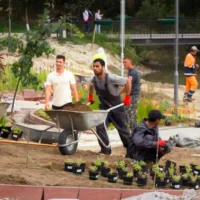Kalocsai Exhibition and Workshop in London
Kalocsa is one of the oldest and most charming towns in Hungary, which is usually associated with the aromatic paprika used for seasoning. Kalocsa is also famous for its flamboyant folk art. To celebrate the specialties of the town, the Hungarian Cultural Centre London in partnership with KrisztinaDesign exhibits the folk art of this versatile city the same weekend as the Festival of Paprika in Kalocsa takes place.
The Kalocsa exhibition will include workshops and interactive activities as well as a video screening showing the beautiful town of Kalocsa and its folk art. Visitors will be able to try on traditional costumes from the region and try their hands at embroidery and painting porcelain with the help of a professional painter.
The hand-decorated porcelain on display is created and sponsored by the Porcelain Manufactory of Kalocsa (www.porcelanfesto.hu). This manufactory has been producing porcelain since 1971 with the help of highly skilled and talented craftswomen. Once the astonishing patterns are painted on the goods, they are shifted to the furnace. The completed products are then ready to turn the dull days into a celebration.
The folk art of the town started to unfold at the end of the 18th century with furniture decoration, followed by the techniques of daubing and embroidery. The motifs were created by pattern designers. The colourful embroidery began to spread around the 1920s, which resulted in the application of more and more colours. The designs of the embroidery are continuously changing and they are being refined as the tradition and skills spread from generation to generation.
The approach of wall flower painting was first mentioned in several notes around the end of the 1800s. Wonderful motley flowers were painted on a blue base and the most commonly used motif was a tulip and a rose. As the patterns were progressing, the flowers on the artworks became more outlined and dense. Also the compositions were converted into more colourful and heavier arrangements. After the Second World War the techniques of daubing on walls began to fade.
The embroidery and daub designs were provided by the women of Kalocsa and Homokmégy and the exhibition has been organized by Krisztina Design and has also been supported by Dee’s Harmony, Fuvarozás Manchester, 6:3 magazin, Vinyl Warriors, HC&HS and Parcelmoving.
Exhibition open: 16-20 September
Opening hours: Mon-Thurs 10am-5pm, Fri 9am–2pm
Formula 1 racing drivers, Lewis Hamilton and Iker Casillas, also fancy the design.
Source: Hungarian Cultural Centre London
please make a donation here
Hot news
Top Hungary news: 3rd-country guest workers will earn less, Buda Castle revamp, Dua Lipa – 14 December, 2024
PHOTOS: Dua Lipa is in Budapest and she’s spending Christmas here!
Balaton light ferry and decorated Budapest cogwheel railway makes Advent brighter – PHOTO GALLERIES
Hungarian embassy in Paris receives threat, says Foreign Minister Szijjártó
Culinary triumph: Michelin Guide acknowledges an unprecedented number of Hungarian restaurants
New motorway stretch, twin tube tunnel inaugurated in Hungary – PHOTOS






